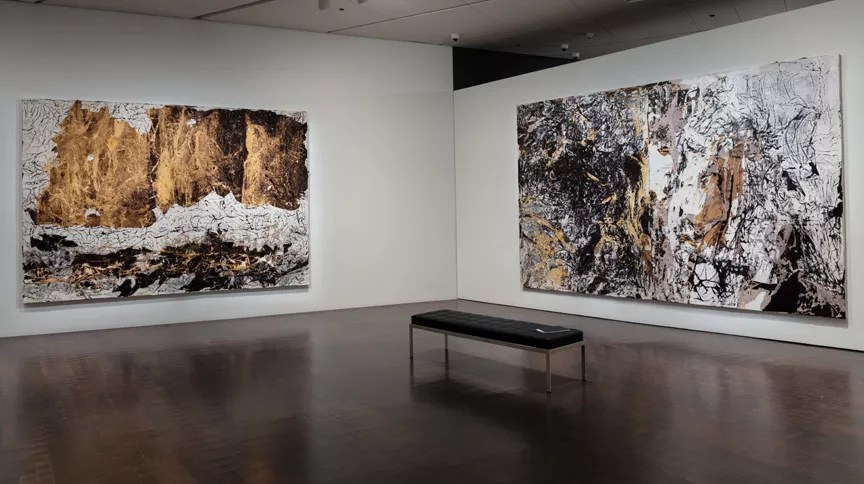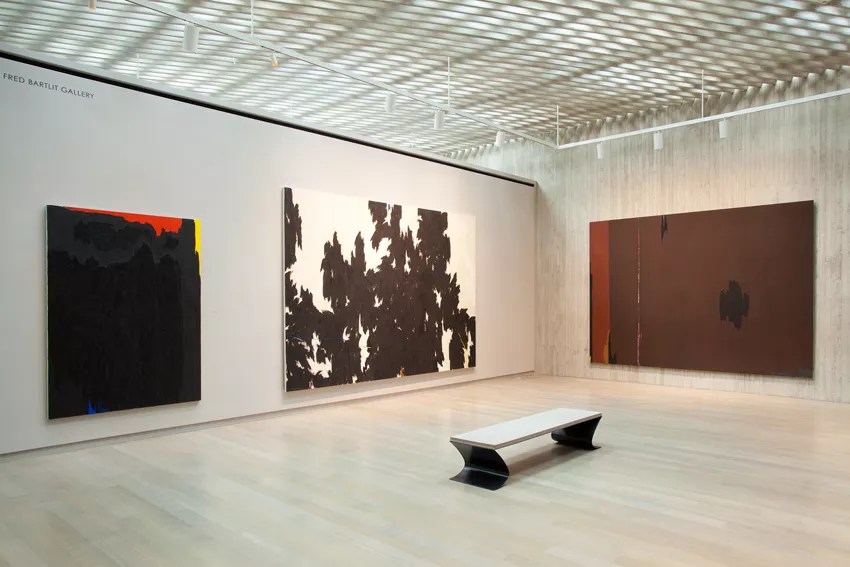
Courtesy Denver Art Museum

Audio By Carbonatix
California-based artist Mark Bradford has experienced a meteoric rise in his reputation over the last few years. He was born in 1961 in south central Los Angeles, in the heart of the black community, where his mother ran a hair salon. Though the family moved to a largely white area when Bradford was a child, his mother still kept the salon in the old neighborhood; after high school, Bradford went to work there as a stylist. Then, at the age of thirty, he entered the renowned California Institute of the Arts, where he earned both his BFA and MFA.
In 2001, just a couple of years after Bradford left school, his work was included in a show at the Studio Museum in Harlem. For those pieces, Bradford created collages using hairdressing end-papers, putting his background in the context of international contemporary art – a super-smart move. He’s been on the up-escalator ever since. A Bradford painting sold at auction in 2015 for the impressive sum of $5.8 million; very few living artists see their work sell for that kind of scratch. And last year he was chosen as the official U.S. representative to the Biennale in Venice this summer, taking on the entire American pavilion and filling it with installations, sculptures and a bunch of his paint-free paintings.
One of the most interesting things about this dizzying ascension is that Bradford has accomplished it with abstraction, sometimes even including text. Though the contemporary art establishment was finished with abstraction, artists like Bradford weren’t. Bradford is African-American and gay, which gave him the hipster credibility to checkmate the art nerds and their devotion to narrative conceptualism: His identity gave him the moral authority to facilitate this radical shift in sensibility. But there’s also his incredibly strong, paradigm-shifting work, conceptual abstraction that recalls abstract expressionism, yet has a social and political context. This must have caught a lot of art theorists, critics and especially contemporary art historians with their philosophical pants down. (It’s actually delicious to watch, especially in light of Damien Hirst’s widely panned melt-down at the same Biennale!)
Bradford is currently the subject of the two-part exhibition Shade: Clyfford Still/Mark Bradford, at the Denver Art Museum and the Clyfford Still Museum. The roots of the show go back to the Albright-Knox Art Gallery in Buffalo, New York. A couple of years ago, Albright-Knox curator Cathleen Chaffee started a series of conversations with Bradford that ultimately led to a show there. It turns out that Bradford was keenly interested in Clyfford Still, in particular his generous use of black, and had been creating works that he intended to be “in dialogue” with Still. Bradford had cited the abstract expressionist giant as among his chief influences; Still was the roughest of the group, Bradford said. The Albright-Knox has the largest collection of Still’s pieces outside of Denver, so Chaffee organized an exhibition of Bradford’s Still-related paintings, along with a selection of the institution’s Stills. (Because of restrictions on the Stills at the Albright-Knox, they could only be shown in a gallery exclusively dedicated to them, so the Bradfords were never seen alongside the Stills in Buffalo.)
Denver, make your New Year’s Resolution Count!
We’re $17,500 away from our End-of-Year campaign goal, with just a five days left! We’re ready to deliver — but we need the resources to do it right. If Westword matters to you, please contribute today to help us expand our current events coverage when it’s needed most.
For Denver, DAM curator Rebecca Hart took Chaffee’s show and tweaked it, adding more Bradfords and securing the loan of three Stills that were not restricted and could therefore be hung by the Bradfords. Over at the CSM, where only Stills can be displayed under the terms of the artist’s will, Shade includes the Stills that most resonated with Bradford.

Elements of Shade, on view at the Denver Art Museum.
Courtesy of the Denver Art Museum
The portion of Shade on view at the DAM begins with quite a bang – Bradford’s magisterial diptych, “Realness,” which the museum recently acquired for its permanent collection. Bradford produced the scabrous surface by laying down sheets or bits of paper that were then torn into shreds; he also sanded, gouged, bleached and in other ways assaulted the paper sheets. Apparently many layers of paper were subjected to such abuses in order to produce the finished painting. On the left, a huge, amorphous black shape floats against a lighter-colored ground while on the right, the ground-color predominates. In a brilliant compositional flourish, the shape on the left simply stops with a hard edge at the margin between the two panels, which is dead in the center. Other closely related Bradford paintings include “Butch Queen” and “Duck Walk.” A second type of Bradford painting in Shade has smoother surfaces and dove-gray palettes that have been produced by applying black paper to the canvas with an adhesive medium and then removing it completely, leaving behind shadow-like images of the paper. In addition to the Shade paintings, Hart has included some earlier Bradfords, one of which anticipates the series: “Edge of Expansion” from 2014.
At the CSM, the Stills selected by Bradford, which he accessed through the museum’s director, Dean Sobel, seem all over the map pictorially, although most are dark in color. These dark colors invariably bring up the topic of race even if they’ve been employed non-objectively, as Still – and Bradford – used them. So there are the expected Stills that are predominately black or dark, including “PH-72,” PH-1078″ and “PH-397,” in which Still applied various shades of black and near-black in heavy, all-over brushstrokes. And one Still, “PH-929,” in which big jagged black shapes are set against white, struck me as being only a stone’s throw away from what Bradford is doing. Many of the Stills that Bradford picked are very surprising, however, like the scene of grotesque nudes bathing in “PH-448,” or the ogre-like walking man in “PH-592”; they appear to have nothing to do with Bradford’s aesthetic.

Clyfford Still’s “PH-949 of 1951,” “PH-929 of 1974” and “PH-1076 of 1953” at the Clyfford Still Museum.
Justin Wambold
But as I considered Bradford’s relationship with Still, it occurred to me that even though the overall compositions don’t resemble Still’s and really look more like critiques of Pollock’s, details of the Stills do resonate with the Bradfords. In some places Still applied paint thickly, in others it’s little more than a stain (or raw canvas); Bradford reinterprets these painterly gestures in torn paper.
Shade at the DAM is an important show, particularly in light of Bradford’s participation in the Biennale. I don’t have the money to travel to Venice, but I did look at the readily available images of Bradford’s entry and it looks sensational. Some of the installations and all of the paintings are closely associated with those on display here in Denver – and the CSM and DAM exhibit is much easier to get to.
Shade: Clyfford Still/Mark Bradford through July 16, the Denver Art Museum, 100 West 14th Avenue Parkway, 720-865-5000, denverartmuseum.org, and the Clyfford Still Museum, 1250 Bannock Street, 720-354-4880, clyffordstillmuseum.org.